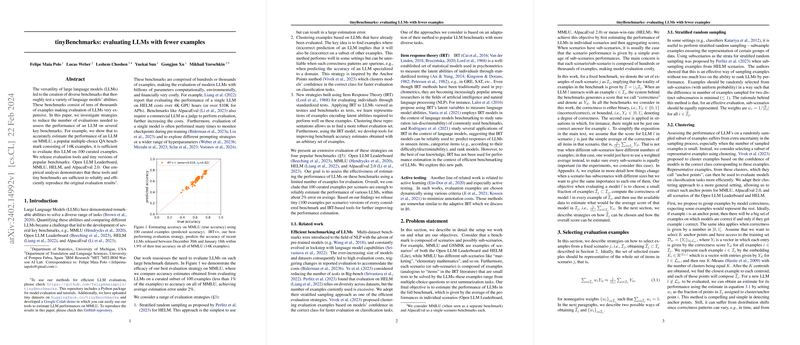Efficient Evaluation of LLMs Using TinyBenchmarks
Introduction to Efficient Benchmarking
The evaluation of LLMs on comprehensive benchmarks has become a cornerstone for measuring advancements in the field of NLP. However, the extensive computational, environmental, and financial costs associated with these evaluations have ignited a search for more efficient methodologies. This paper introduces tinyBenchmarks, an approach that significantly reduces the number of examples needed to accurately estimate LLM performance across various key benchmarks. By curating a subset of 100 examples, this method achieves an average estimation error under 2%, effectively addressing the challenge of resource-intensive evaluation processes.
The Problem of Costly Evaluations
Evaluating LLMs involves testing models across numerous examples to ascertain their abilities comprehensively. Traditional benchmarks, including those like MMLU, Open LLM Leaderboard, HELM, and AlpacaEval 2.0, consist of hundreds or thousands of examples. The detailed analysis provided by these benchmarks comes at a very high cost, with single model evaluations requiring thousands of GPU hours or substantial financial investment, especially when commercial models are utilized as part of the evaluation process.
Evaluation Strategies and Empirical Analysis
The research investigates three primary strategies for reducing the number of evaluation examples without compromising the reliability of performance estimation:
- Stratified Random Sampling, the simplest approach, though it can result in larger estimation errors.
- Clustering Based on Correctness Patterns, which performs well in some contexts but can be unreliable due to potential spurious correctness patterns, particularly with domain-specific LLMs.
- Item Response Theory (IRT) Based Evaluation, which utilizes standardized testing methodologies to identify robust evaluation sets and develop tools for accurate performance estimation with any subset of examples.
The empirical analysis demonstrates the superiority of the IRT-based approach, which efficiently predicts the performance of LLMs on all considered benchmarks with minimal examples. Tiny versions of benchmarks released alongside IRT-based tools underscore the practical application of the research findings.
Theoretical and Practical Implications
The paper substantiates the potential of IRT methods in streamlining LLM evaluations, supporting the practical utility of tinyBenchmarks. This efficient evaluation facilitates more frequent testing across development cycles, especially during fine-tuning and prompt engineering, thereby expediting the iterative process of model improvement. Furthermore, the research proposes extensions to prompt evaluation and adaptive testing, indicating directions for future advancements in efficient LLM benchmarking strategies.
Limitations and Future Directions
While tinyBenchmarks significantly mitigate evaluation costs, the approach faces challenges in scenarios involving severe distribution shifts, such as rapid advancements in model capabilities or significant changes in model architectures. To counteract these limitations, periodic updates to the example set and IRT model recalibrations are recommended.
Conclusion
This paper presents a significant step forward in the efficient evaluation of LLMs, offering the NLP research community a method to reduce the computational and financial burdens of benchmark testing. The release of tinyBenchmarks and related tools paves the way for more sustainable and frequent evaluations, contributing to the accelerated pace of innovation in LLM development.
